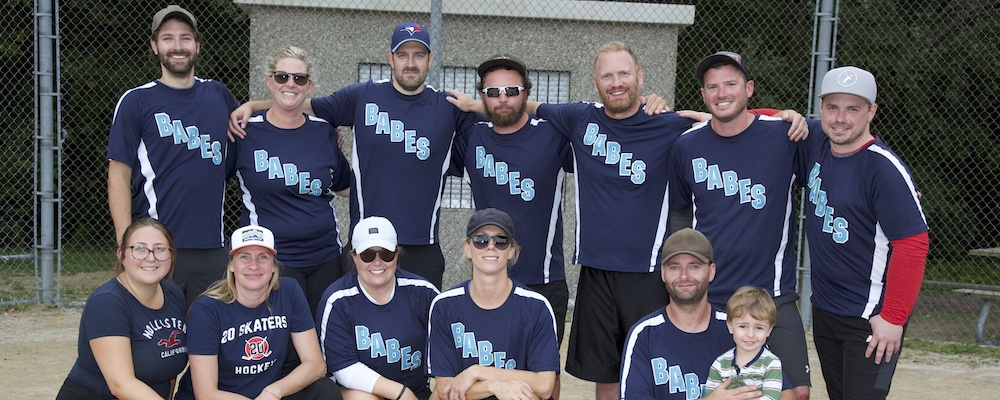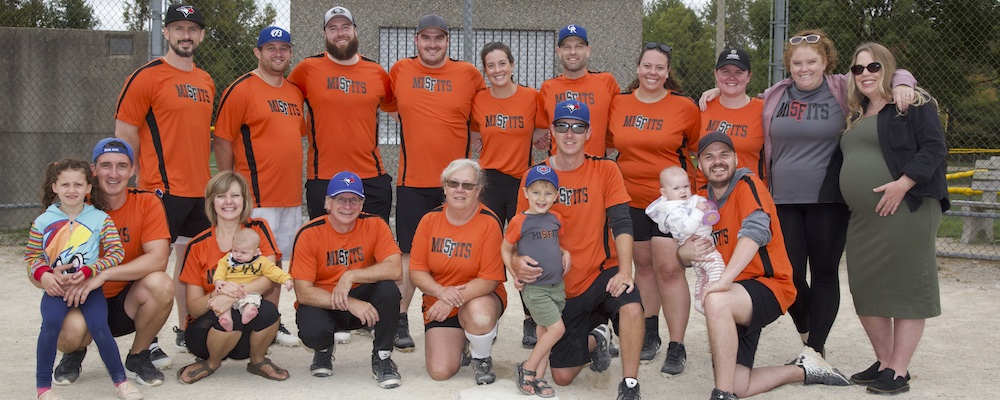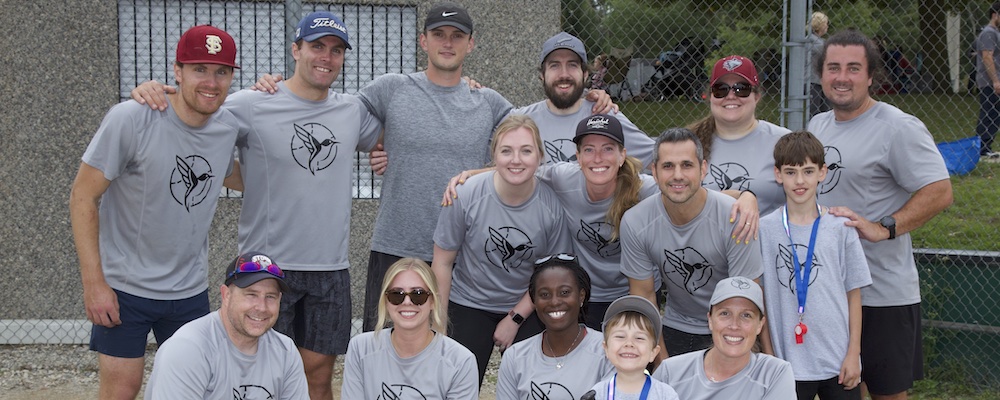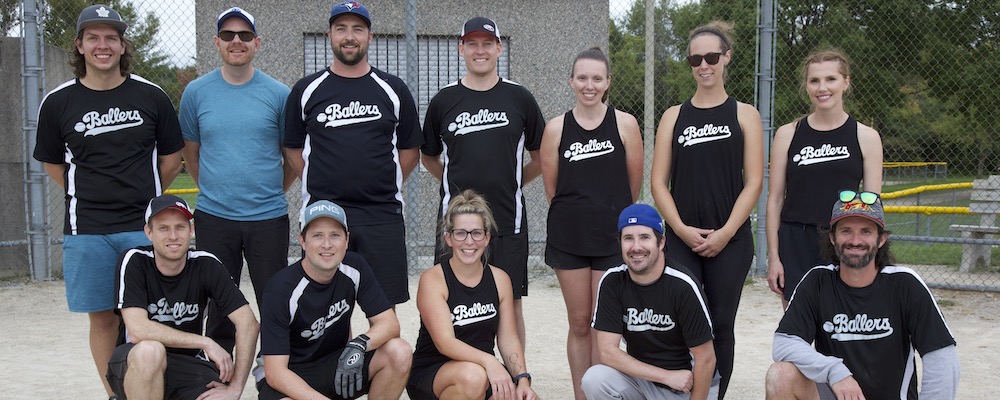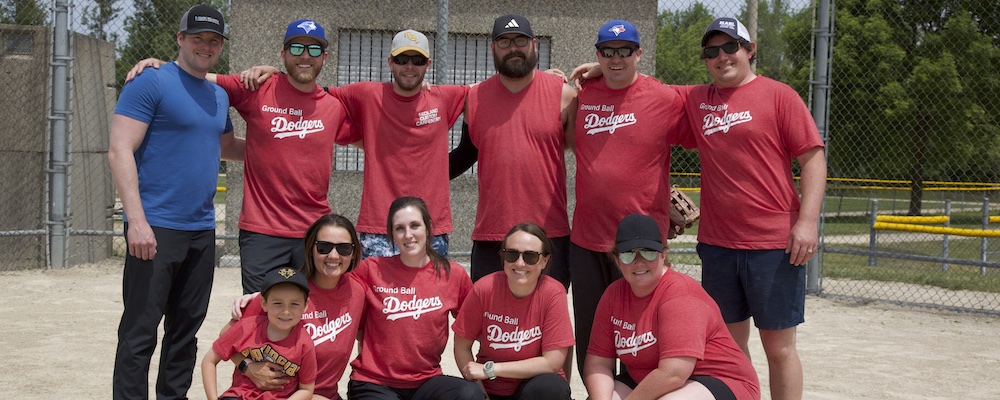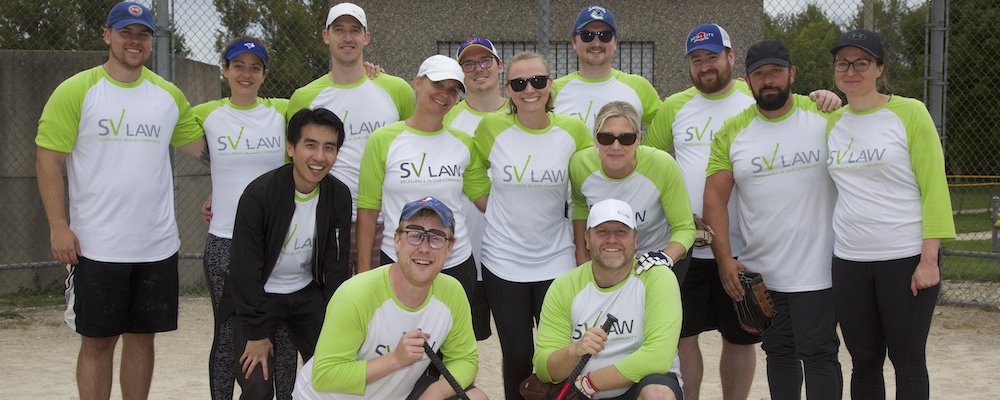Official League Rules
1.0 GENERAL
Game Time
1.1 Games are played every Thursday night starting at 6:30 p.m. Ball diamonds have been booked for pre-game practices at 6:00 p.m. A default occurs if a team is not prepared to play by 6:45 p.m.
Minimum Number of Players
1.2 An automatic default will occur if a team has less than eight(8) players to start the game. (also see Rule 3.1)
Game Duration
1.3 The game will be nine(9) innings in length. If there is a tie after the end of nine innings, one extra inning can be played if time permits. The decision to play extra inning must be agreed upon by the captains prior to the game starting, otherwise, a tie will be recorded.
NOTE (effective in 1999) Captains may decide to shorten games to seven innings due to darkness.
Equipment
1.4 Every team is responsible for supplying its own bats, gloves and bases. No hard ball bats are to be used. Bats must be SPN approved according to their website (http://www.slo-pitch.com/content/slo-pitch-national-bat-policy-0) and all bats previously meeting the No Sox rules (prior to the rule change; 2014) will continue to be acceptable for use. Balls will be supplied to each team at the beginning of the season. The Home Team is to supply the game ball. Metal cleats are not permitted on players’s footwear.
Home Team
1.5 The designated Home Team has a choice between first field or first bats.
Start of Game
1.6 Prior to the start of play, captains for each team are to meet to discuss and agree upon ground rules for the game, including, but not limited to, items such as the out of play lines, any issues unique to a particular diamond, etc. (added 2006)
2.0 THE BATTING TEAM
Batting Order
2.1 The batting order must be set at the beginning of the game and any additional players must be added to the bottom of the order. All persons who will be playing at any time in the field must be included in the batting order.
2.2 (rule removed – 04/22)
2.3 No additional players can be added after two complete innings have been played unless agreed upon between team captains.
2.4 Once the batting order is set, it does not change with who fielded in the last inning. Everyone included in the batting order must field at least two (2) innings unless an injury, occurring during the game, prohibits it. (rev. 06/22)
If a batter hits out of order and the error is discovered while the incorrect batter is at bat, the correct batter takes his/her place and legally assumes any balls and strikes. No outs are recorded. Nothing happens to the incorrect batter.
If the error is discovered after the incorrect batter has batted, and before the next pitch to the following batter, the player who should have batted is out. Nothing happens to the incorrect batter. Any advance or score made by a base runner because of a batted ball by the improper batter shall be nullified. The next batter is the player whose name follows that of the player called out for failing to bat. All base runners are returned to the base they occupied prior to the incorrect batter.
If the error is discovered after a pitch(es) to the next batter, the turn at-bat of the incorrect batter is legal, all runs scored and bases attained are legal and the next batter shall be the one that is supposed to be hitting (i.e. the results of the at-bat by the incorrect batter stand as if it was the correct batter).
No base-runner shall be removed from the base he/she is occupying to bat in his/her proper place. He/she merely misses his/her turn at bat with no penalty. The batter following him/her in the batting order becomes the legal batter.
The call can be made by either team.
2.5 The batting order must not have more than three (3) men batting in a row, even if it results in a woman batting more than once through the entire batting order. If the women have to bat more than once, then they must take their second bats in the order they appear on the batting order.
7 Runs Maximum Rule
2.6 Each team may score a maximum of seven (7) runs per inning. Once a team scores it’s 7th run, the inning immediately ends. The 9th inning, or any final inning as agreed by the captains, will be an open inning. (replaces 10th Batter Rule – 04/22)
2.7 In the ninth (9) inning (and any agreed upon last or extra inning) each team will be entitled to have as many batters bat as they are able, prior to having three (3) batters called out. Pitcher/Pitching
2.8 The team up at bat will supply its own pitcher who pitches only three (3) underhand pitches per batter. If the ball is not put into play upon the third pitch, the batter is out. A tick or foul ball on the third pitch is not considered a pitch and one additional pitch may be thrown. (new rule 1993)
2.9 Anyone on the batting team can pitch and substitutions may be made between batters. Warm-up pitches are not permitted upon substitution.
2.10 No fielding player shall stand closer to the batter than the pitcher.
2.11 If the pitcher touches the ball in any way after it has been hit, the batter is automatically out and any base runners cannot advance. The only exception to this rule is if the pitcher cannot avoid being hit in self-defense (i.e. protecting face from a line drive). The ball is dead and a strike is not counted.
2.12 The pitcher must not interfere with the fielding team after the ball has been hit.
2.13 All play stops when the ball is returned from within the gravel area to the pitcher’s mound in a controlled manner.
Umpires
2.14 The batting team shall supply the umpires.
2.15 The umpire at 1st base calls the play at 1st base and home plate. The umpire at 3rd base calls the play at 2nd and 3rd base. Foul balls will be called by the catcher. Umpires may consult to determine the correct call.
2.16 A tie play on a base goes to the runner.
Fair / Foul / In-Play / Out-of-Play
2.17 In addition to foul balls, the catcher will also determine whether or not a ball has gone out of play. A ball is out of play if it is thrown or hit outside the imaginary lines drawn from edges of the backstop.
2.18 If a ball is overthrown and goes out-of-play, all runners get 2 bases from the last base the runner had possession of when the ball left the fielder’s hand. An exception is made to this rule if it occurs when the 10th batter is hitting as described in rule 2.6. (revised in 2015)
2.19 A ball hit beyond the out-of-play area is not a fly ball, but is instead a foul ball.
2.20 If the ball is hit in fair territory and hits a runner that is off the bag, the runner is automatically out.
2.21 If the ball is hit in fair territory and hits a runner that is on the bag, the ball is fair and in play, even if the ball bounces into foul in-play area. The runner is safe and must advance if there is an advancing runner behind him/her. If the ball goes out of play, the runner takes the base he/she was going to plus one.
2.22 If a ball is hit and is deflected off or by any fielding player into foul territory but not out-of-play, the ball is live. If the ball is deflected out-of-play, the batter gets 1st base plus second base, and any runner advance to the base he/she were going to plus one. If the ball is caught in foul territory but the player’s momentum carries him/her into out-of-play territory, the play is still live and any base-runners may advance at their own risk once the ball is caught.(revised in 1994)
Over-running Bases
2.23 A runner can overrun 1st base safely. However, the runner has to be tagged out on second or third base, if the base is overrun. If the play is forced the runner does not have to be tagged as long as the person on base has control of the ball and has contact with the bag before the runner reaches that base.
Tagging Up
2.24 A runner may tag up after an outfield fly ball has been caught as long as the ball is still in play. (Please note rule 2.22 on out-of-play fly balls)
Interference
2.25 No runner shall interfere with a player that is making a play on the ball. If the runner causes interference, the runner is out.
2.26 No player may deliberately block access to a base or interfere with an advancing runner. Interference occurs when a player blocks or obstructs a runner when that player is not making a play on the ball. If this type of interference occurs, the runner advances to his/her base and is safe.
Sliding
2.27 There is no deliberate sliding. Sliding is defined as any portion of the body, other than the feet, making contact with the ground or the bag when the runner is approaching a base. This rule is not intended to include tripping over the base, reaching back on an overrun, tripping over one’s feet, or general awkwardness.
Bunting
2.28 There is no deliberate bunting. Anyone who does is, automatically out.
Stealing and lead-offs
2.29 There is no base-stealing and no lead-offs. A lead-off will be called by the 1st and 3rd base umpires if the runner’s foot leaves the bag before the batter makes contact with the ball.
Fly Balls
2.30 Prior to each game, the captains will agree to a reference point on the backstop screen that will be used to determine the required height for a fly ball. If a foul ball to the catcher reaches or exceeds this height and the catcher catches the ball in the air, the batter is out, regardless of the count. If a batter fouls the first or second pitch of an at bat to the catcher and the ball does not reach the agreed upon height, it is a foul ball, regardless of whether the ball is caught or not. In this situation, the ball is dead, a strike is counted, and the at bat continues. The pitcher or umpires are to determine if a foul ball has reached the agreed upon height. A foul tip on the 3rd strike, if caught by the catcher, will be an out regardless of the height. Any disagreements will be settled by the captains. (revised 04/23)
Infield Fly Rule
2.31 If a batter hits a fly ball within the fair gravel area and there is a force play with at least a runner on first and second base, in a situation with zero or one out, then the Infield Fly Rule is in effect.
If the infield fly is called and the fly ball is caught within the fair gravel area, it is treated exactly as an ordinary fly ball; the batter is out, there is no force, and the runners must tag up before advancing. On the other hand, if the infield fly rule is called and the ball lands fair within in the gravel area and remains fair without being caught, the batter is still out, there is no force on the runners, but the runners are not required to tag up before advancing.
Further, if the fly ball is near the foul lines, the infield fly rule is only in effect if the ball lands and remains in fair territory. If the ball is not caught and ends up foul (including if it lands fair and then rolls foul and remains foul before passing the bases), infield fly is cancelled, and the play is treated as an ordinary foul ball. In contrast, if the ball lands foul and then rolls fair, before passing the bases, infield fly takes effect and the batter is out. If a fly ball lands foul in the gravel area beyond the bases – by rule it is a foul ball and infield fly does not apply. Conversely, if the fly ball lands fair in the gravel area beyond the bases then bounces/rolls foul, by rule it is a fair ball and infield fly would apply because it’s a fair ball.
2.32 Any player from either team or base coach may call the Infield Fly Rule. The rule must be called while the ball is in the air. Umpires are to call the rule during the year-end tournament.
Any further disagreements shall be settled by the captains/umpires.
Halfway Line
2.33 Once a runner has crossed the halfway line between 3rd base and home plate, the runner must continue to home plate and cannot return to 3rd base. The exception is in the case of a pop fly, whereby the runner may return to 3rd base.
Home Run Limit
2.34 A home run limit is in effect at Woodland Glen and Guthrie fields. Each team shall be permitted a maximum of four (4) home runs per game. Each subsequent home run hit will result in the batter being called out. (added 2018)
3.0 THE FIELDING TEAM
Minimum Number of Women per Team
3.1 There must be a minimum of least three (3) women in the field at any one time. However, there is a maximum of six (6) men in the field at any one time. If only three (3) women are in the field, the team must play with nine (9) fielders rather than the maximum of 10 as noted in rule 3.2. An automatic default will occur if there are less than three(3) women on a team (see Rule 1.2)
Fielding Positions
3.2 The team in the field will consist of a maximum of ten(10) players. The various fielding positions will include: three(3) fielders, three(3) base persons, one (1) catcher, one(l) shortstop, one(1) rover (who can play infield or outfield as the team chooses and can change positions at anytime during the game and one( 1) pitcher substitute.
3.3 There is to be no smoking by anyone (batting or fielding) on the field of play (including base coaches). Anyone refusing to abide by this rule is automatically suspended for the balance of the game, and subject to penalties outlined in 5.6/5.7 below. (Added 2006)
3.4 A maximum of five (5) fielders may be positioned on the infield, defined as the gravel section of field at all diamonds, prior to a batter making contact with the ball. The fielders shall be the three (3) base persons, one (1) shortstop, and one (1) rover. Once the ball is hit, any fielder may field the ball on any part of the field. (added 2018)
4.0 THE PLAYING FIELD
Bases
4.1 The bases are approximately 60 feet apart (18-20 paces). The bases must be pegged down securely by the home team before the commencement of play.
First Base
4.2 A double bag will be used at first base. The centre of the bag, separating the orange bag and white bag, will be placed on the base line. The runner must touch the orange bag(which is in foul territory) before the 1st baseman touches the white bag. If a runner touches the white bag, he/she is automatically out unless there is no realistic play on first base. The only exception is if the runner is trying for second and the runner may then touch the white bag safely.
Every effort will be made by the fielding player to avoid contact/collision with base runners.
Home Plate
4.3 To avoid collisions and possible injuries at home plate, a runner shall not touch the base to score. A line will be drawn from the point of home plate to the backstop, with such a line being a continuation of the 1st base line. The runner must cross this home plate line and make contact with the ground prior to the catcher having control of the ball and having contact with home plate. If the runner touches home plate he/she is automatically out. A runner may be tagged between 3rd base and home plate. (revised 1994) The catcher must be able to perform his/her tasks without takeover by other fielding players. (Extra bodies behind the plate increases risk of collisions and injuries)(revised 1999)
A runner may be tagged out between 3rd base and the commit line. Once the runner passes the commit line, an out can only be recorded by throwing the ball to the catcher at home plate (i.e. the runner cannot be tagged out once they pass the commit line). All put-out attempts at home plate must be first handled/attempted by the catcher. If the ball gets past the catcher, a different fielder may cover home plate to record an out.
Base Lines
4.4 The home team is responsible for chalking the line from home plate through to the backstop (Rule 4.3) as well as the halfway line between third and home plate (Rule 2.33).
Pitching Mound
4.5 The pitching mound will be marked, as agreed by the captains, prior to the game with a line approximately 30 feet from home plate. The line will be approximately 3 feet wide with the centre of the line being directly in-line with home plate. All pitchers must begin their delivery from behind the confines of the line. Upon releasing the pitch, pitchers may position themselves as they desire so long as they are not interfering with the fielding team.
Pitching Screen
4.6 Teams are permitted the use of a pitching screen. The location of the screen would be the same as the pitcher, according to rule 4.5. A ball making contact with the screen off of the bat (i.e. before a play is made, on the live ball) will be considered a dead ball according to rule 2.11, as if accidental contact were made by the pitcher (added 2014).
5.0 OTHER MATTERS
Injuries
5.1 At any time a player, whether on the batting team or fielding team, is injured, time is called and play is stopped and no further outs shall be recorded. The advancing runner returns to his/her last base, except where the runner has crossed the halfway line between 3rd base and home plate: that runner proceeds home.
5.2 If a player is injured and cannot run on his/her turn at bat, the last player of the same sex to get out shall be the substitute runner, subject to agreement otherwise by the Captains. The substitute runner must stand behind the extension of the 3rd base line and may only advance after the batter makes contact with the ball. If a player is injured during the game and is unable to bat, the team skips that person in their batting order, and substitutes in the last out of the same sex, should that render the lineup illegal.
5.3 There will only be substitutions for this injured in the game being played, unless agreed upon by the Captains. Captains, please use common sense.
Rain Outs
5.4 A rained out game will be called at the diamond by the Captains. All rained out games will be treated as a tie. No make up games will be played. If a game is played, it counts.
Complete Games
5.5 A game is complete and counts if six (6) full innings have been played or if five and one half (5 1/2) innings have been played with the losing team having had their bats in the top of the 6th inning. If a game is called because of rain at any point after this six (6) innings, the score that counts is the one at the last complete inning.
Unsportmanlike Conduct
5.6 If any player behaves in an unsportmanlike manner, the opposing team Captain may ask that player’s Captain to have the person sit out the remainder of the game. In addition, any such complaint made against a player must be reported to the acting convenor on the day following the game in which the complaint was made.
Player Suspension
5.7 A complaint made under Rule 5.6 constitutes an automatic first warning to the player. If a second complaint is received about the same player during the season, a meeting will be called with all team Captains (revised 1999) during which time they will discuss the imposing of a penalty against that player. This penalty may take the form of game suspensions and may include being asked to sit out for the rest of the season.
Minimum Age
5.8 All new players in the league must be at least 22 years of age or turn 22 during the season (revised 1995).
Eligibility for PIay-offs
1.9 Only those players which have played at least half the scheduled games during the regular season will be entitled to play in the playoff tournament unless the League has given specific approval for a player who has not fulfilled this requirement to play. (Playing in the June Tournament will count for one (1) game towards the required number of regular season games – No June Tournament in 2002).
Playoff Games
5.10 For the first set of playoff games (immediately subsequent to end of regular season, played on the following Thursday night) games start at 6:00 PM, instead of the normal 6:30 start time. Games are 7 innings long. Should lighting start to become an issue, the captains of each team are to decide at the beginning of each inning whether or not to complete the inning. Once so decided, the inning is either completed, or game is completed. Should the score be tied at the end of the final inning, the winner is deemed to be the team that last held the lead at the end of a completed inning.
Appeals
5.11 All appeals must be made in writing and submitted to the commissioner no later than the final regular season game.(revised 1999)
Rule Changes
5.12 Any captain wishing to change any of the league rules must put the change in writing and submit to the commissioner one week prior to a scheduled meeting of the Captains. (revised 1999).
Regular Season Tie-Breaking
5.13 In the event of a tie in the regular season standings, the tie-breaking rules will be as follows: 1) Head to head to record, the team with the most victories against the team it is tied with will be the higher seed. 2) Should the teams still be tied after considering head-to-head record, run differential for the entire season will be the second tie-breaker (i.e. a team’s total runs scored minus total runs allowed)
Download a PDF copy of the official League Rules here: Guelph No-Sox Softball League Rules (04-2023)



